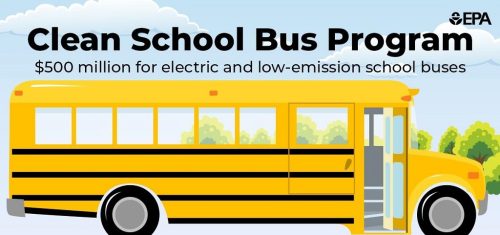For many schoolchildren, their day begins with riding a school bus filled with their classmates’ chatter and laughter. Most parents, educators, and school districts have no idea that this seemingly safe method of transportation may be the most dangerous part of the day for their children’s health. Early exposure to diesel exhaust fumes from a school bus, a known carcinogen, can have adverse health outcomes that carry through to adulthood, including uncontrolled asthma, insomnia, obesity, and other pulmonary complications. Children and bus operators navigate exhaust levels that are 23 to 46 times higher than what’s considered by the Environmental Protection Agency (EPA) to be a significant risk for cancer. Low-income Americans and Black, Indigenous, and Latinx children are more likely to be exposed to diesel pollution and therefore suffer those adverse health outcomes because they are more likely to rely on school buses and live near bus depots, major roadways, and other sources of industrial and vehicle pollution.
Reducing this harmful air pollution by replacing diesel buses with electric school buses in low-income communities of color is a step in the right direction toward addressing historic environmental injustices. WE ACT for Environmental Justice has a long history of advocating for clean air and transportation for communities that have been disproportionately affected by diesel pollution. With initiatives like the Dirty Diesel Campaign, our work spurred New York’s Metropolitan Transportation Authority to replace its fleet with cleaner transit buses, reducing 95 percent of tailpipe emissions citywide. Most recently, we successfully advocated for the passage of Local Law 120 of 2021, which requires school buses that serve New York City Public Schools to be all-electric by 2035. As the Biden administration seeks to address long-standing injustices in these overburdened communities through the Justice40 initiative, $500 million has been earmarked by the EPA to help school districts replace aging diesel-run bus fleets with zero-emission vehicles.
The EPA’s Clean School Bus 2022 Rebate Program, created under the Bipartisan Infrastructure bill, provides public school districts, nonprofit school transportation associations, and some school transportation contractors funding to replace diesel-fueled school buses with electric buses. This funding prioritizes serving overburdened communities of color in high-need/low-income areas, rural communities, and tribal school districts. If selected, funding will be provided to school districts upfront, before the purchase of a new school bus is made. With some school-day commutes being upwards of 45 minutes, we have the opportunity to drastically reduce the amount of asthma-inducing and carcinogenic pollution that follows children into the schoolyard.

Dana Johnson, WE ACT for Environmental Justice’s Senior Director of Strategy and Federal Policy, at the Environmental Protection Agency’s 2022 Clean School Bus Rebate Program launch.
WE ACT is here to help you navigate and take full advantage of this opportunity. Here are three things you can do right now to help kids and families in your community breathe a bit easier:
1. Contact your school district
Believe it or not, many schools have not heard about this opportunity, and time is running out to take advantage of the first round of funding. Connect with the administrators of your local public-integrated school district to encourage them to take advantage of the rebate program. Applications close on August 19, 2022. There is also funding for electric vehicle charging infrastructure. Encourage your school district to work with the local utility early and often through the application process to ensure they have the necessary charging infrastructure for electric school buses.
2. Is your school district a priority one?
At least 40 percent of funds must go to schools that stand to benefit the most – low-income communities of color. The Bipartisan Infrastructure Law of 2021 includes the prioritization of high-need, Tribal, and rural school districts. Applicants requesting funding for the replacement of school buses that serve a prioritized school district will be offered more funding per bus and receive preference in the selection process. If your local school district is in a priority community, tell administrators to reach out to their regional EPA office or local Clean Cities Coalition for more information on applying.
3. Contact your EPA regional office
Reach out to your regional EPA office to let them know you want clean, zero-emission school buses in your community, and encourage them to connect with your school district. EPA program administrators in your regional office can contact school administrators and walk them through the application process through webinars and hands-on technical help.
This rebate program is a great start toward helping our communities redress the consequences of inequities in infrastructure development and exposures to harmful air pollution. And this is just the beginning! The Bipartisan Infrastructure Law of 2021 has allocated $5 billion over the next five years towards helping school buses transition to zero-tailpipe, electric fleets in communities that need it the most: low-income and communities of color that are unduly burdened by diesel pollution. Updated guidance on new programs, grants, and initiatives is being released throughout the year. Be sure to follow us on social media, subscribe to WE ACT’s email newsletter, and find additional resources from our coalition partners, the Alliance for Electric School Buses, to stay in the know about this and upcoming funding opportunities available under the Clean School Bus program.

Anastasia Gordon is the Energy and Transportation Policy Manager at WE ACT for Environmental Justice.

